Contemporary Hotel Marketing Analysis: Sea World Resort Gold Coast
VerifiedAdded on 2020/04/13
|28
|6790
|41
Report
AI Summary
This report provides a comprehensive marketing analysis of Sea World Resort Gold Coast, Australia. It begins with an executive summary and then delves into a marketing audit, including corporate connections and a review of products and services. The external environment is assessed using a PESTLE analysis, followed by a competitive analysis and examination of commercial partners. The internal environment is then evaluated through SWOT analysis, internal research, organizational structure audits, and segmentation and targeting. Based on these assessments, the report sets objectives and goals, outlining an action plan with strategies, tactics, resource requirements, and evaluation methods. Key performance indicators and priorities are also detailed. The report concludes with a summary of findings and recommendations, providing a strategic roadmap for the hotel's marketing efforts. The report aims to grow both the domestic and international family markets for the hotel.
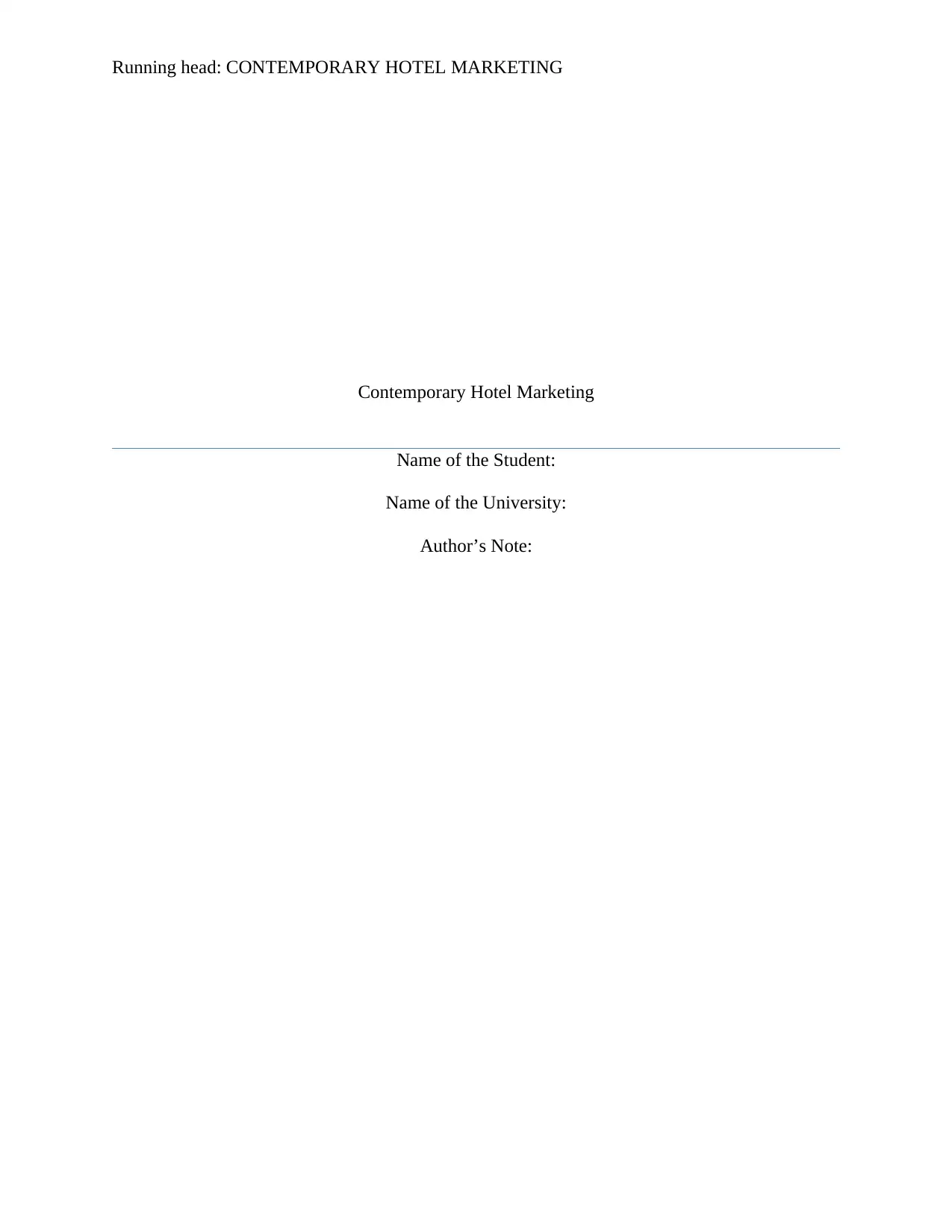
Running head: CONTEMPORARY HOTEL MARKETING
Contemporary Hotel Marketing
Name of the Student:
Name of the University:
Author’s Note:
Contemporary Hotel Marketing
Name of the Student:
Name of the University:
Author’s Note:
Paraphrase This Document
Need a fresh take? Get an instant paraphrase of this document with our AI Paraphraser
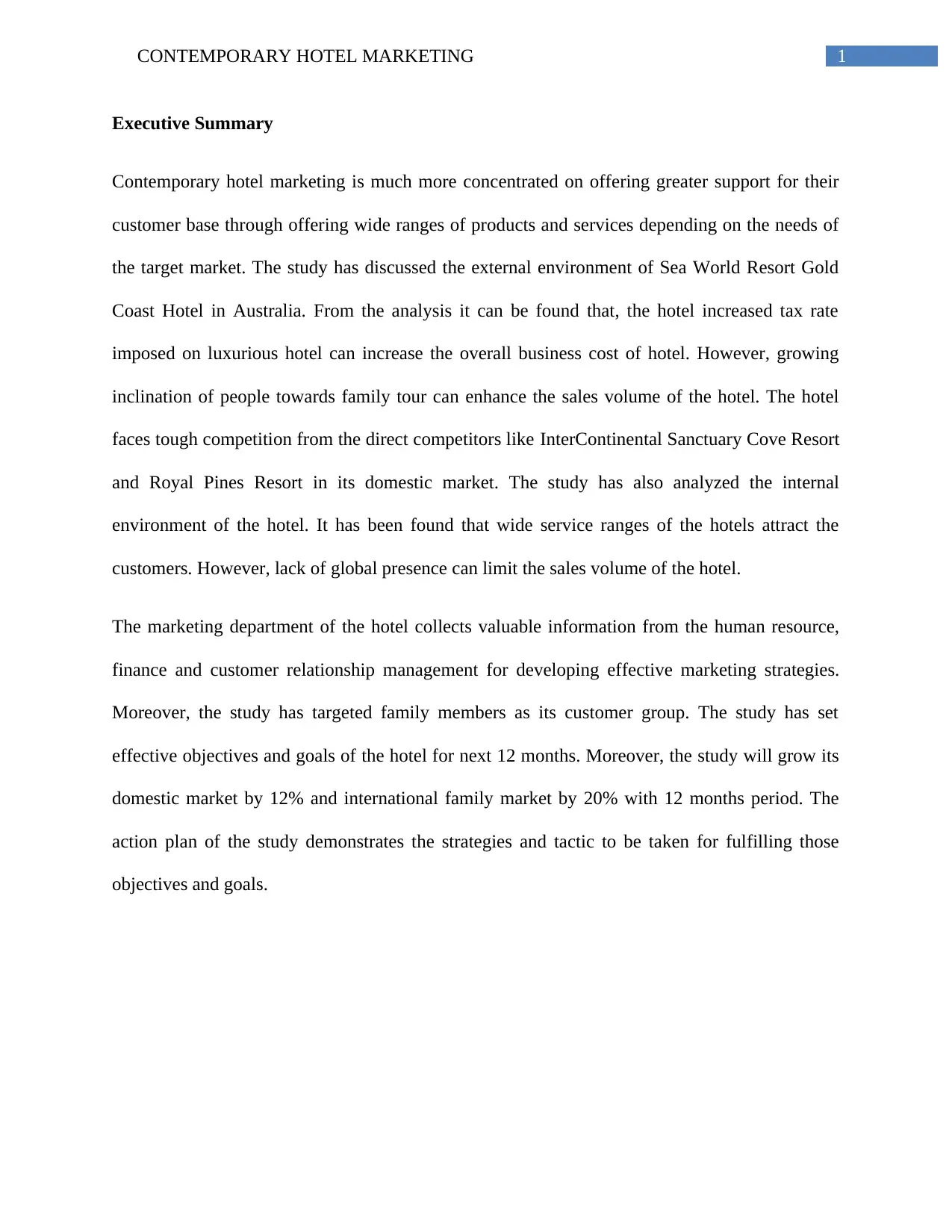
1CONTEMPORARY HOTEL MARKETING
Executive Summary
Contemporary hotel marketing is much more concentrated on offering greater support for their
customer base through offering wide ranges of products and services depending on the needs of
the target market. The study has discussed the external environment of Sea World Resort Gold
Coast Hotel in Australia. From the analysis it can be found that, the hotel increased tax rate
imposed on luxurious hotel can increase the overall business cost of hotel. However, growing
inclination of people towards family tour can enhance the sales volume of the hotel. The hotel
faces tough competition from the direct competitors like InterContinental Sanctuary Cove Resort
and Royal Pines Resort in its domestic market. The study has also analyzed the internal
environment of the hotel. It has been found that wide service ranges of the hotels attract the
customers. However, lack of global presence can limit the sales volume of the hotel.
The marketing department of the hotel collects valuable information from the human resource,
finance and customer relationship management for developing effective marketing strategies.
Moreover, the study has targeted family members as its customer group. The study has set
effective objectives and goals of the hotel for next 12 months. Moreover, the study will grow its
domestic market by 12% and international family market by 20% with 12 months period. The
action plan of the study demonstrates the strategies and tactic to be taken for fulfilling those
objectives and goals.
Executive Summary
Contemporary hotel marketing is much more concentrated on offering greater support for their
customer base through offering wide ranges of products and services depending on the needs of
the target market. The study has discussed the external environment of Sea World Resort Gold
Coast Hotel in Australia. From the analysis it can be found that, the hotel increased tax rate
imposed on luxurious hotel can increase the overall business cost of hotel. However, growing
inclination of people towards family tour can enhance the sales volume of the hotel. The hotel
faces tough competition from the direct competitors like InterContinental Sanctuary Cove Resort
and Royal Pines Resort in its domestic market. The study has also analyzed the internal
environment of the hotel. It has been found that wide service ranges of the hotels attract the
customers. However, lack of global presence can limit the sales volume of the hotel.
The marketing department of the hotel collects valuable information from the human resource,
finance and customer relationship management for developing effective marketing strategies.
Moreover, the study has targeted family members as its customer group. The study has set
effective objectives and goals of the hotel for next 12 months. Moreover, the study will grow its
domestic market by 12% and international family market by 20% with 12 months period. The
action plan of the study demonstrates the strategies and tactic to be taken for fulfilling those
objectives and goals.
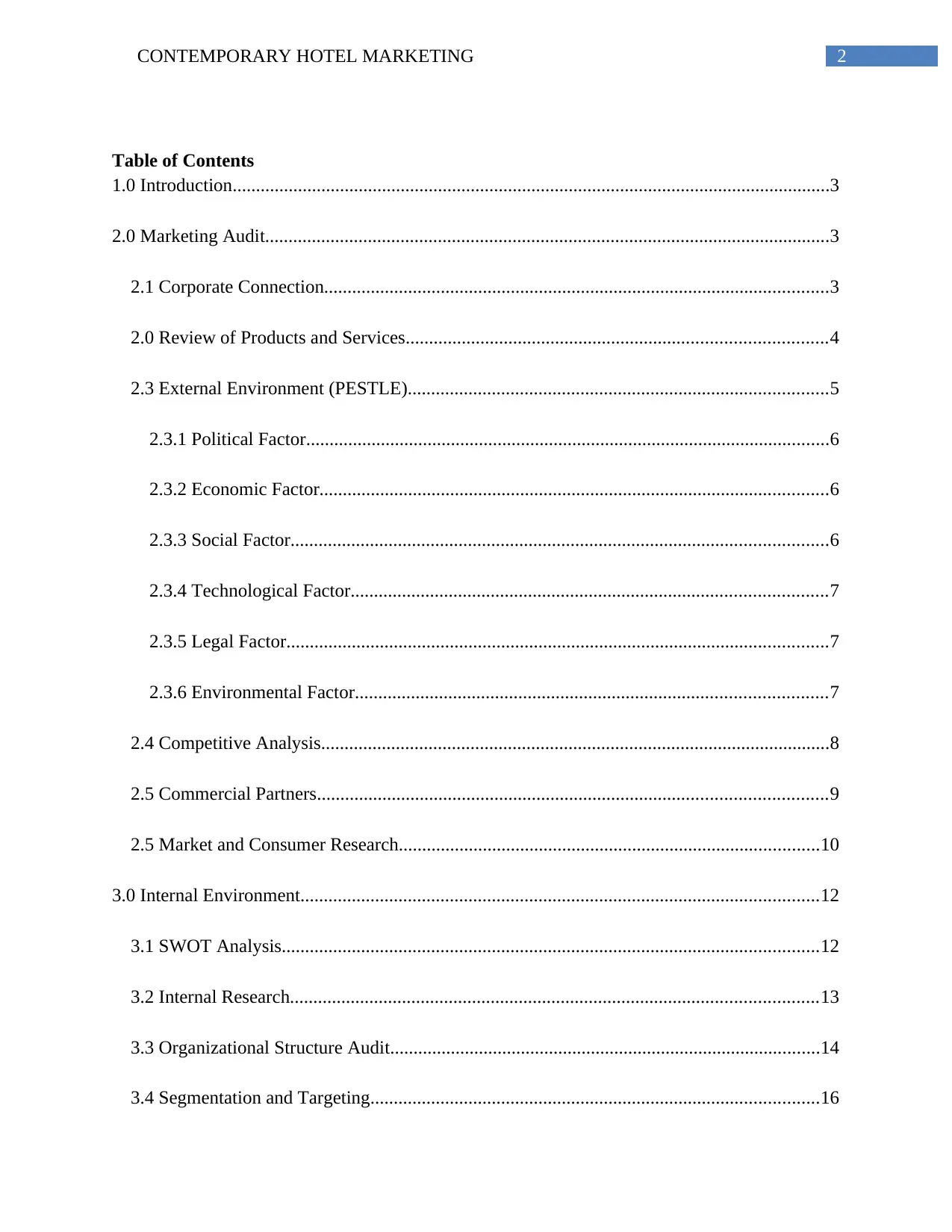
2CONTEMPORARY HOTEL MARKETING
Table of Contents
1.0 Introduction................................................................................................................................3
2.0 Marketing Audit.........................................................................................................................3
2.1 Corporate Connection............................................................................................................3
2.0 Review of Products and Services..........................................................................................4
2.3 External Environment (PESTLE)..........................................................................................5
2.3.1 Political Factor................................................................................................................6
2.3.2 Economic Factor.............................................................................................................6
2.3.3 Social Factor...................................................................................................................6
2.3.4 Technological Factor......................................................................................................7
2.3.5 Legal Factor....................................................................................................................7
2.3.6 Environmental Factor.....................................................................................................7
2.4 Competitive Analysis.............................................................................................................8
2.5 Commercial Partners.............................................................................................................9
2.5 Market and Consumer Research..........................................................................................10
3.0 Internal Environment...............................................................................................................12
3.1 SWOT Analysis...................................................................................................................12
3.2 Internal Research.................................................................................................................13
3.3 Organizational Structure Audit............................................................................................14
3.4 Segmentation and Targeting................................................................................................16
Table of Contents
1.0 Introduction................................................................................................................................3
2.0 Marketing Audit.........................................................................................................................3
2.1 Corporate Connection............................................................................................................3
2.0 Review of Products and Services..........................................................................................4
2.3 External Environment (PESTLE)..........................................................................................5
2.3.1 Political Factor................................................................................................................6
2.3.2 Economic Factor.............................................................................................................6
2.3.3 Social Factor...................................................................................................................6
2.3.4 Technological Factor......................................................................................................7
2.3.5 Legal Factor....................................................................................................................7
2.3.6 Environmental Factor.....................................................................................................7
2.4 Competitive Analysis.............................................................................................................8
2.5 Commercial Partners.............................................................................................................9
2.5 Market and Consumer Research..........................................................................................10
3.0 Internal Environment...............................................................................................................12
3.1 SWOT Analysis...................................................................................................................12
3.2 Internal Research.................................................................................................................13
3.3 Organizational Structure Audit............................................................................................14
3.4 Segmentation and Targeting................................................................................................16
⊘ This is a preview!⊘
Do you want full access?
Subscribe today to unlock all pages.

Trusted by 1+ million students worldwide
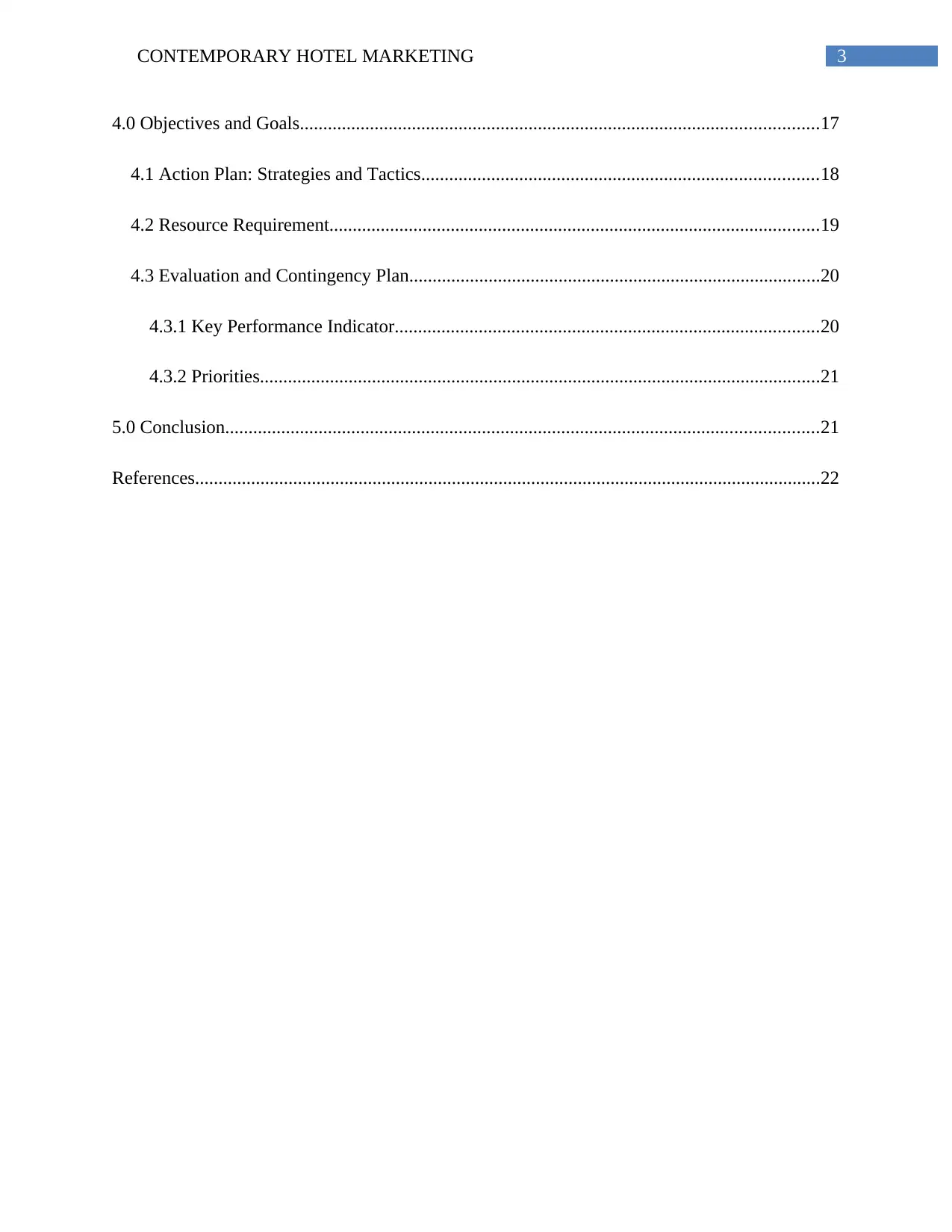
3CONTEMPORARY HOTEL MARKETING
4.0 Objectives and Goals...............................................................................................................17
4.1 Action Plan: Strategies and Tactics.....................................................................................18
4.2 Resource Requirement.........................................................................................................19
4.3 Evaluation and Contingency Plan........................................................................................20
4.3.1 Key Performance Indicator...........................................................................................20
4.3.2 Priorities........................................................................................................................21
5.0 Conclusion...............................................................................................................................21
References......................................................................................................................................22
4.0 Objectives and Goals...............................................................................................................17
4.1 Action Plan: Strategies and Tactics.....................................................................................18
4.2 Resource Requirement.........................................................................................................19
4.3 Evaluation and Contingency Plan........................................................................................20
4.3.1 Key Performance Indicator...........................................................................................20
4.3.2 Priorities........................................................................................................................21
5.0 Conclusion...............................................................................................................................21
References......................................................................................................................................22
Paraphrase This Document
Need a fresh take? Get an instant paraphrase of this document with our AI Paraphraser
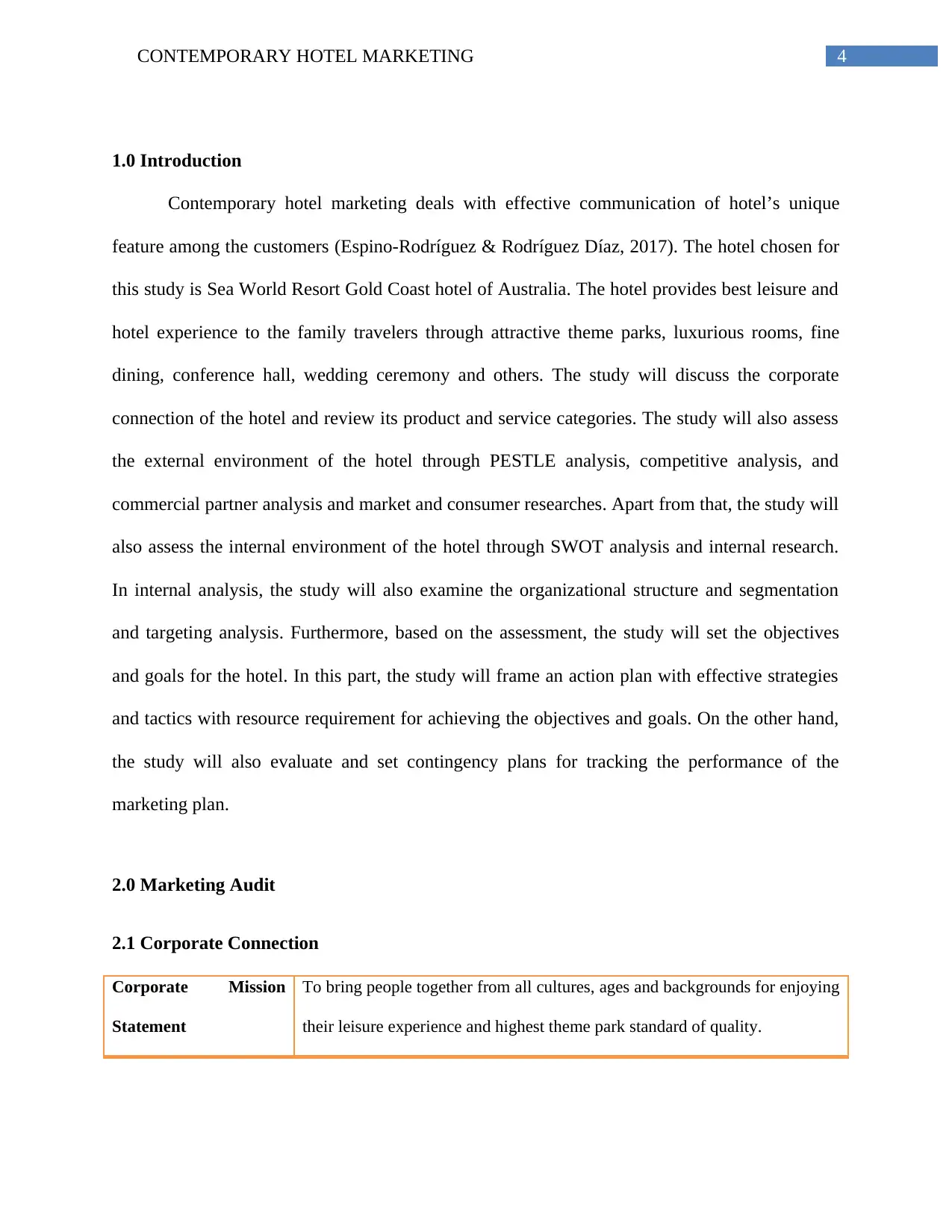
4CONTEMPORARY HOTEL MARKETING
1.0 Introduction
Contemporary hotel marketing deals with effective communication of hotel’s unique
feature among the customers (Espino-Rodríguez & Rodríguez Díaz, 2017). The hotel chosen for
this study is Sea World Resort Gold Coast hotel of Australia. The hotel provides best leisure and
hotel experience to the family travelers through attractive theme parks, luxurious rooms, fine
dining, conference hall, wedding ceremony and others. The study will discuss the corporate
connection of the hotel and review its product and service categories. The study will also assess
the external environment of the hotel through PESTLE analysis, competitive analysis, and
commercial partner analysis and market and consumer researches. Apart from that, the study will
also assess the internal environment of the hotel through SWOT analysis and internal research.
In internal analysis, the study will also examine the organizational structure and segmentation
and targeting analysis. Furthermore, based on the assessment, the study will set the objectives
and goals for the hotel. In this part, the study will frame an action plan with effective strategies
and tactics with resource requirement for achieving the objectives and goals. On the other hand,
the study will also evaluate and set contingency plans for tracking the performance of the
marketing plan.
2.0 Marketing Audit
2.1 Corporate Connection
Corporate Mission
Statement
To bring people together from all cultures, ages and backgrounds for enjoying
their leisure experience and highest theme park standard of quality.
1.0 Introduction
Contemporary hotel marketing deals with effective communication of hotel’s unique
feature among the customers (Espino-Rodríguez & Rodríguez Díaz, 2017). The hotel chosen for
this study is Sea World Resort Gold Coast hotel of Australia. The hotel provides best leisure and
hotel experience to the family travelers through attractive theme parks, luxurious rooms, fine
dining, conference hall, wedding ceremony and others. The study will discuss the corporate
connection of the hotel and review its product and service categories. The study will also assess
the external environment of the hotel through PESTLE analysis, competitive analysis, and
commercial partner analysis and market and consumer researches. Apart from that, the study will
also assess the internal environment of the hotel through SWOT analysis and internal research.
In internal analysis, the study will also examine the organizational structure and segmentation
and targeting analysis. Furthermore, based on the assessment, the study will set the objectives
and goals for the hotel. In this part, the study will frame an action plan with effective strategies
and tactics with resource requirement for achieving the objectives and goals. On the other hand,
the study will also evaluate and set contingency plans for tracking the performance of the
marketing plan.
2.0 Marketing Audit
2.1 Corporate Connection
Corporate Mission
Statement
To bring people together from all cultures, ages and backgrounds for enjoying
their leisure experience and highest theme park standard of quality.
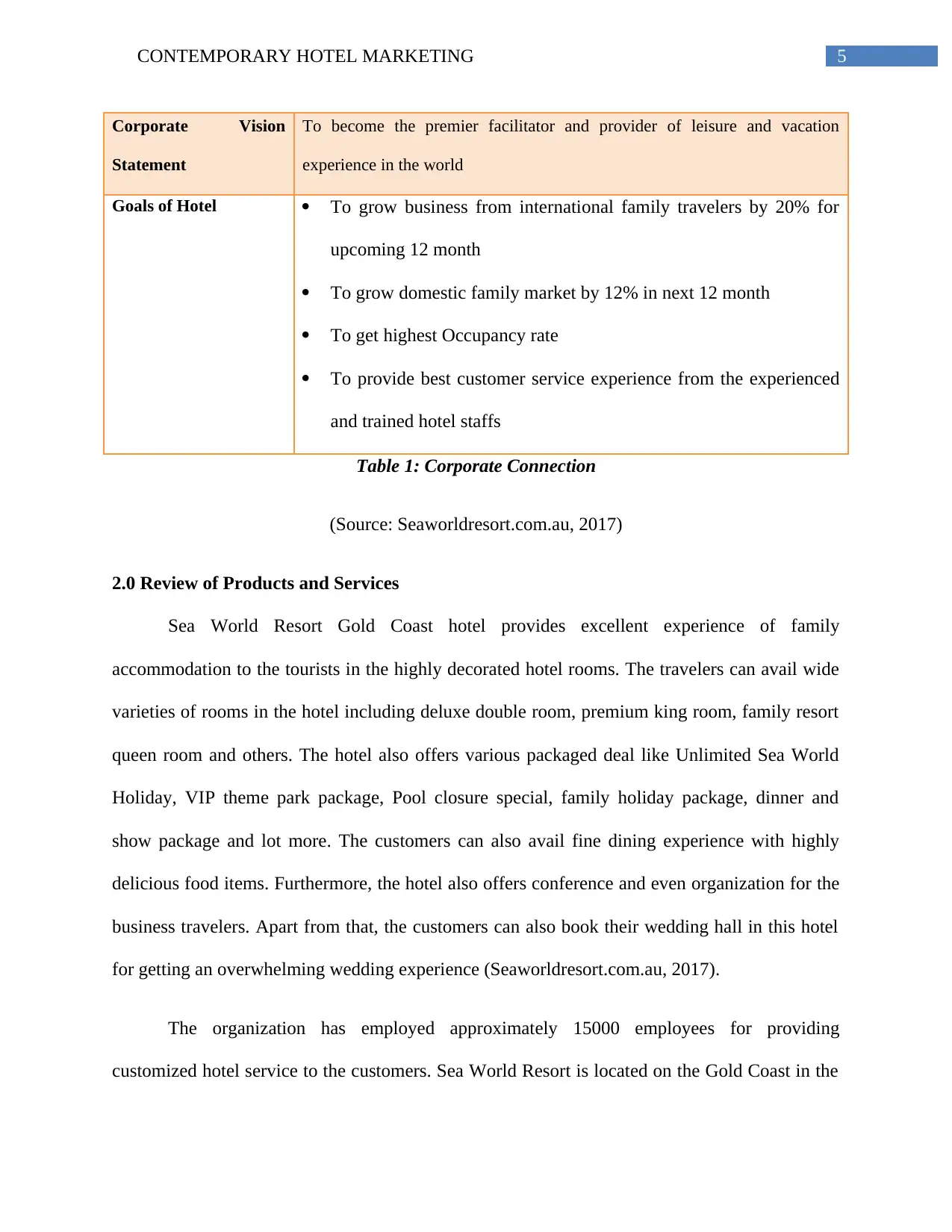
5CONTEMPORARY HOTEL MARKETING
Corporate Vision
Statement
To become the premier facilitator and provider of leisure and vacation
experience in the world
Goals of Hotel To grow business from international family travelers by 20% for
upcoming 12 month
To grow domestic family market by 12% in next 12 month
To get highest Occupancy rate
To provide best customer service experience from the experienced
and trained hotel staffs
Table 1: Corporate Connection
(Source: Seaworldresort.com.au, 2017)
2.0 Review of Products and Services
Sea World Resort Gold Coast hotel provides excellent experience of family
accommodation to the tourists in the highly decorated hotel rooms. The travelers can avail wide
varieties of rooms in the hotel including deluxe double room, premium king room, family resort
queen room and others. The hotel also offers various packaged deal like Unlimited Sea World
Holiday, VIP theme park package, Pool closure special, family holiday package, dinner and
show package and lot more. The customers can also avail fine dining experience with highly
delicious food items. Furthermore, the hotel also offers conference and even organization for the
business travelers. Apart from that, the customers can also book their wedding hall in this hotel
for getting an overwhelming wedding experience (Seaworldresort.com.au, 2017).
The organization has employed approximately 15000 employees for providing
customized hotel service to the customers. Sea World Resort is located on the Gold Coast in the
Corporate Vision
Statement
To become the premier facilitator and provider of leisure and vacation
experience in the world
Goals of Hotel To grow business from international family travelers by 20% for
upcoming 12 month
To grow domestic family market by 12% in next 12 month
To get highest Occupancy rate
To provide best customer service experience from the experienced
and trained hotel staffs
Table 1: Corporate Connection
(Source: Seaworldresort.com.au, 2017)
2.0 Review of Products and Services
Sea World Resort Gold Coast hotel provides excellent experience of family
accommodation to the tourists in the highly decorated hotel rooms. The travelers can avail wide
varieties of rooms in the hotel including deluxe double room, premium king room, family resort
queen room and others. The hotel also offers various packaged deal like Unlimited Sea World
Holiday, VIP theme park package, Pool closure special, family holiday package, dinner and
show package and lot more. The customers can also avail fine dining experience with highly
delicious food items. Furthermore, the hotel also offers conference and even organization for the
business travelers. Apart from that, the customers can also book their wedding hall in this hotel
for getting an overwhelming wedding experience (Seaworldresort.com.au, 2017).
The organization has employed approximately 15000 employees for providing
customized hotel service to the customers. Sea World Resort is located on the Gold Coast in the
⊘ This is a preview!⊘
Do you want full access?
Subscribe today to unlock all pages.

Trusted by 1+ million students worldwide
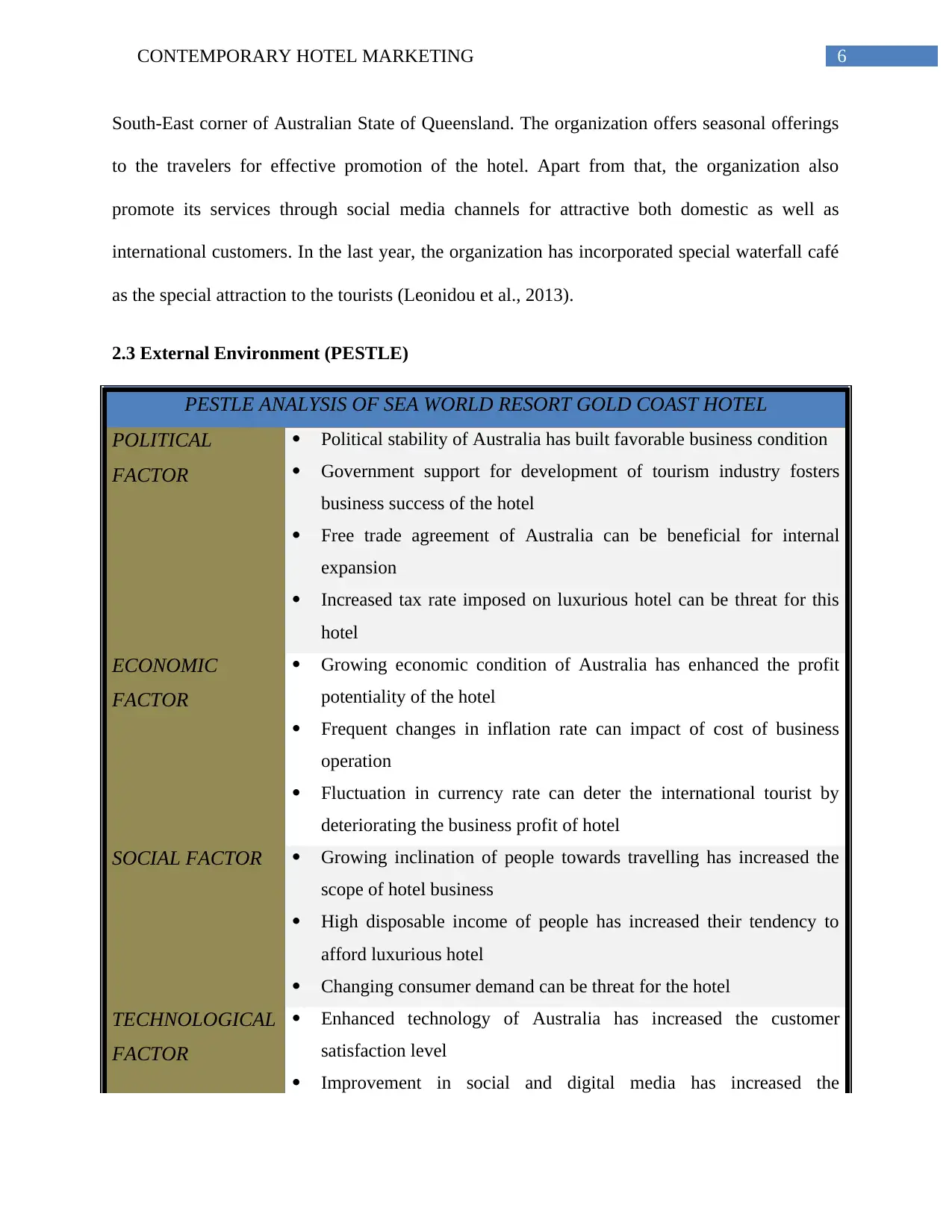
6CONTEMPORARY HOTEL MARKETING
South-East corner of Australian State of Queensland. The organization offers seasonal offerings
to the travelers for effective promotion of the hotel. Apart from that, the organization also
promote its services through social media channels for attractive both domestic as well as
international customers. In the last year, the organization has incorporated special waterfall café
as the special attraction to the tourists (Leonidou et al., 2013).
2.3 External Environment (PESTLE)
PESTLE ANALYSIS OF SEA WORLD RESORT GOLD COAST HOTEL
POLITICAL
FACTOR
Political stability of Australia has built favorable business condition
Government support for development of tourism industry fosters
business success of the hotel
Free trade agreement of Australia can be beneficial for internal
expansion
Increased tax rate imposed on luxurious hotel can be threat for this
hotel
ECONOMIC
FACTOR
Growing economic condition of Australia has enhanced the profit
potentiality of the hotel
Frequent changes in inflation rate can impact of cost of business
operation
Fluctuation in currency rate can deter the international tourist by
deteriorating the business profit of hotel
SOCIAL FACTOR Growing inclination of people towards travelling has increased the
scope of hotel business
High disposable income of people has increased their tendency to
afford luxurious hotel
Changing consumer demand can be threat for the hotel
TECHNOLOGICAL
FACTOR
Enhanced technology of Australia has increased the customer
satisfaction level
Improvement in social and digital media has increased the
South-East corner of Australian State of Queensland. The organization offers seasonal offerings
to the travelers for effective promotion of the hotel. Apart from that, the organization also
promote its services through social media channels for attractive both domestic as well as
international customers. In the last year, the organization has incorporated special waterfall café
as the special attraction to the tourists (Leonidou et al., 2013).
2.3 External Environment (PESTLE)
PESTLE ANALYSIS OF SEA WORLD RESORT GOLD COAST HOTEL
POLITICAL
FACTOR
Political stability of Australia has built favorable business condition
Government support for development of tourism industry fosters
business success of the hotel
Free trade agreement of Australia can be beneficial for internal
expansion
Increased tax rate imposed on luxurious hotel can be threat for this
hotel
ECONOMIC
FACTOR
Growing economic condition of Australia has enhanced the profit
potentiality of the hotel
Frequent changes in inflation rate can impact of cost of business
operation
Fluctuation in currency rate can deter the international tourist by
deteriorating the business profit of hotel
SOCIAL FACTOR Growing inclination of people towards travelling has increased the
scope of hotel business
High disposable income of people has increased their tendency to
afford luxurious hotel
Changing consumer demand can be threat for the hotel
TECHNOLOGICAL
FACTOR
Enhanced technology of Australia has increased the customer
satisfaction level
Improvement in social and digital media has increased the
Paraphrase This Document
Need a fresh take? Get an instant paraphrase of this document with our AI Paraphraser
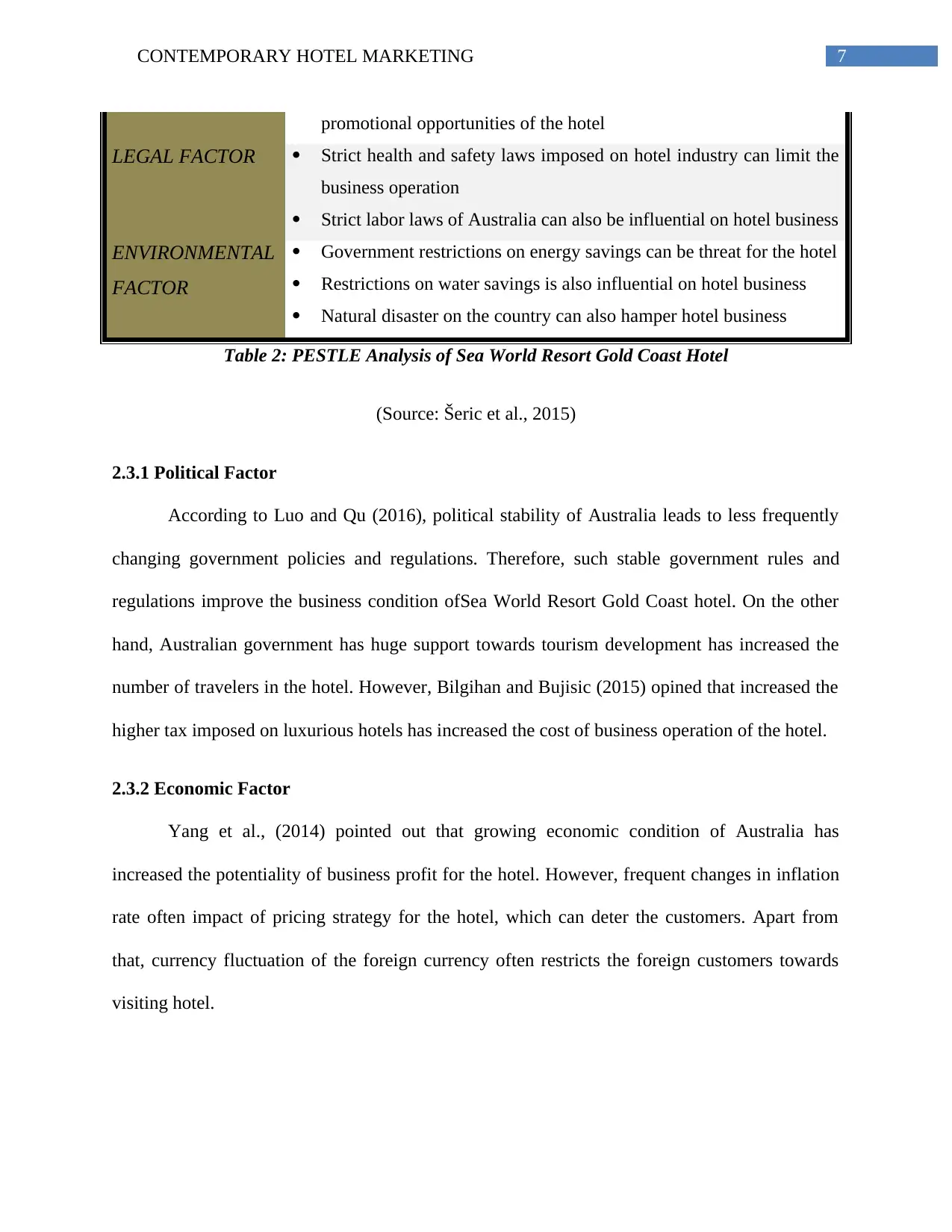
7CONTEMPORARY HOTEL MARKETING
promotional opportunities of the hotel
LEGAL FACTOR Strict health and safety laws imposed on hotel industry can limit the
business operation
Strict labor laws of Australia can also be influential on hotel business
ENVIRONMENTAL
FACTOR
Government restrictions on energy savings can be threat for the hotel
Restrictions on water savings is also influential on hotel business
Natural disaster on the country can also hamper hotel business
Table 2: PESTLE Analysis of Sea World Resort Gold Coast Hotel
(Source: Šeric et al., 2015)
2.3.1 Political Factor
According to Luo and Qu (2016), political stability of Australia leads to less frequently
changing government policies and regulations. Therefore, such stable government rules and
regulations improve the business condition ofSea World Resort Gold Coast hotel. On the other
hand, Australian government has huge support towards tourism development has increased the
number of travelers in the hotel. However, Bilgihan and Bujisic (2015) opined that increased the
higher tax imposed on luxurious hotels has increased the cost of business operation of the hotel.
2.3.2 Economic Factor
Yang et al., (2014) pointed out that growing economic condition of Australia has
increased the potentiality of business profit for the hotel. However, frequent changes in inflation
rate often impact of pricing strategy for the hotel, which can deter the customers. Apart from
that, currency fluctuation of the foreign currency often restricts the foreign customers towards
visiting hotel.
promotional opportunities of the hotel
LEGAL FACTOR Strict health and safety laws imposed on hotel industry can limit the
business operation
Strict labor laws of Australia can also be influential on hotel business
ENVIRONMENTAL
FACTOR
Government restrictions on energy savings can be threat for the hotel
Restrictions on water savings is also influential on hotel business
Natural disaster on the country can also hamper hotel business
Table 2: PESTLE Analysis of Sea World Resort Gold Coast Hotel
(Source: Šeric et al., 2015)
2.3.1 Political Factor
According to Luo and Qu (2016), political stability of Australia leads to less frequently
changing government policies and regulations. Therefore, such stable government rules and
regulations improve the business condition ofSea World Resort Gold Coast hotel. On the other
hand, Australian government has huge support towards tourism development has increased the
number of travelers in the hotel. However, Bilgihan and Bujisic (2015) opined that increased the
higher tax imposed on luxurious hotels has increased the cost of business operation of the hotel.
2.3.2 Economic Factor
Yang et al., (2014) pointed out that growing economic condition of Australia has
increased the potentiality of business profit for the hotel. However, frequent changes in inflation
rate often impact of pricing strategy for the hotel, which can deter the customers. Apart from
that, currency fluctuation of the foreign currency often restricts the foreign customers towards
visiting hotel.
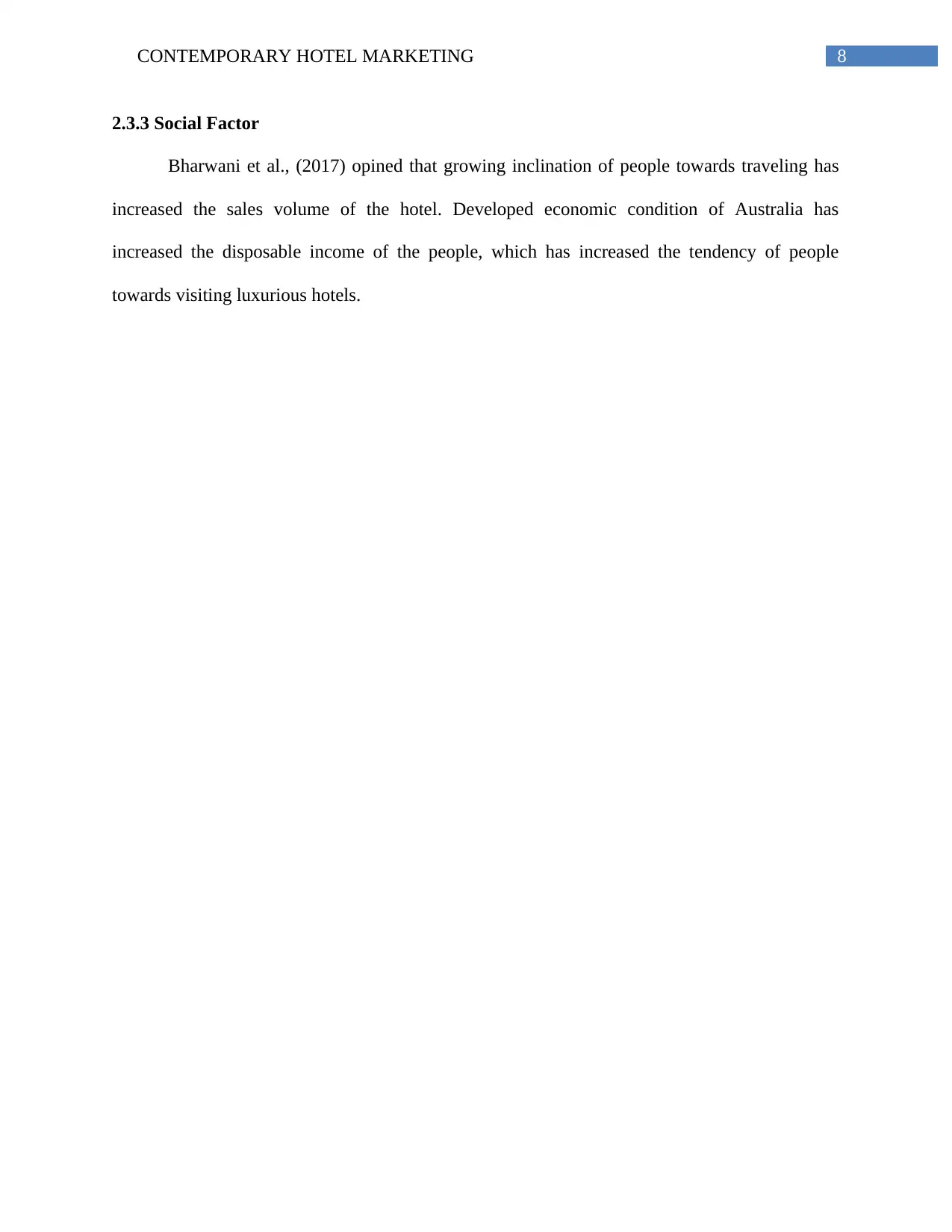
8CONTEMPORARY HOTEL MARKETING
2.3.3 Social Factor
Bharwani et al., (2017) opined that growing inclination of people towards traveling has
increased the sales volume of the hotel. Developed economic condition of Australia has
increased the disposable income of the people, which has increased the tendency of people
towards visiting luxurious hotels.
2.3.3 Social Factor
Bharwani et al., (2017) opined that growing inclination of people towards traveling has
increased the sales volume of the hotel. Developed economic condition of Australia has
increased the disposable income of the people, which has increased the tendency of people
towards visiting luxurious hotels.
⊘ This is a preview!⊘
Do you want full access?
Subscribe today to unlock all pages.

Trusted by 1+ million students worldwide
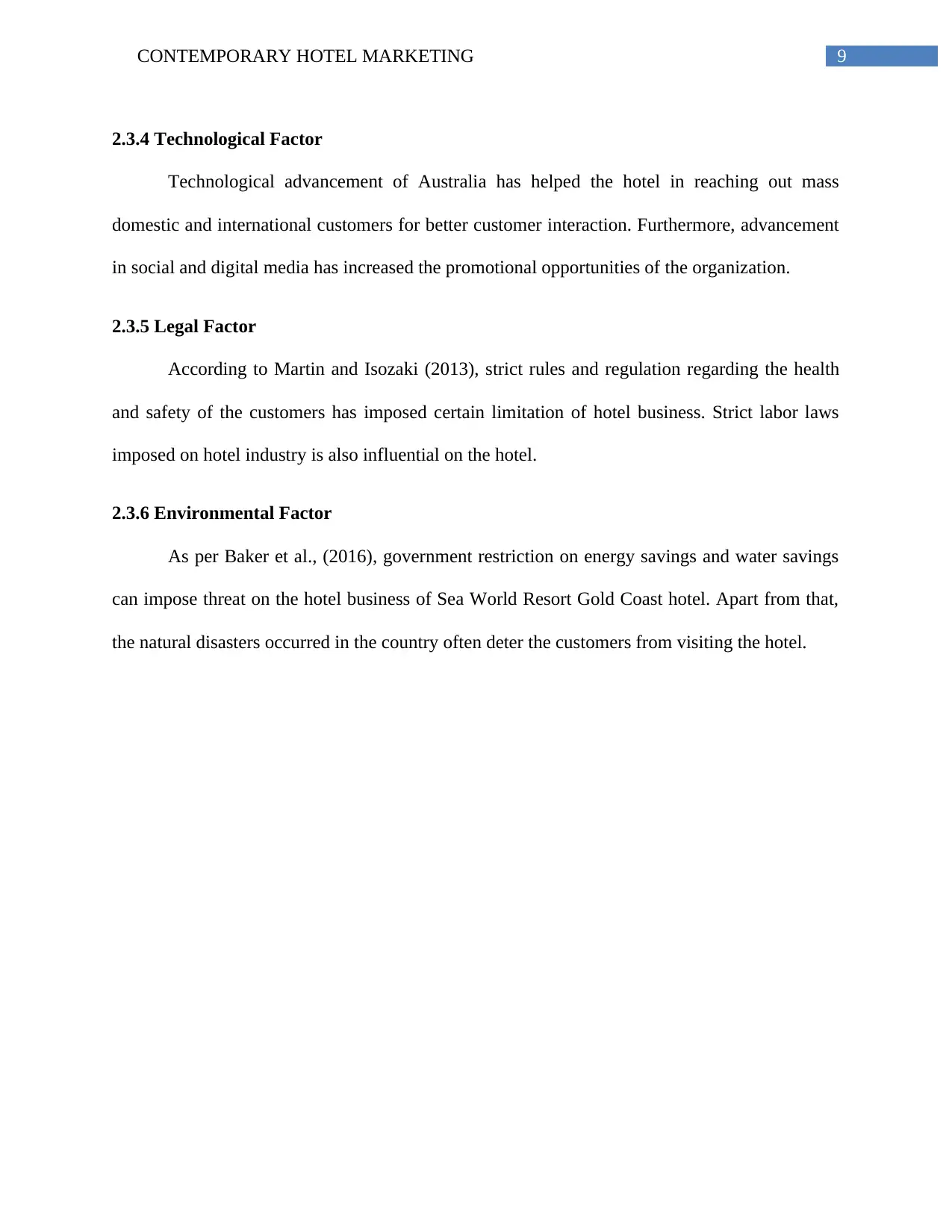
9CONTEMPORARY HOTEL MARKETING
2.3.4 Technological Factor
Technological advancement of Australia has helped the hotel in reaching out mass
domestic and international customers for better customer interaction. Furthermore, advancement
in social and digital media has increased the promotional opportunities of the organization.
2.3.5 Legal Factor
According to Martin and Isozaki (2013), strict rules and regulation regarding the health
and safety of the customers has imposed certain limitation of hotel business. Strict labor laws
imposed on hotel industry is also influential on the hotel.
2.3.6 Environmental Factor
As per Baker et al., (2016), government restriction on energy savings and water savings
can impose threat on the hotel business of Sea World Resort Gold Coast hotel. Apart from that,
the natural disasters occurred in the country often deter the customers from visiting the hotel.
2.3.4 Technological Factor
Technological advancement of Australia has helped the hotel in reaching out mass
domestic and international customers for better customer interaction. Furthermore, advancement
in social and digital media has increased the promotional opportunities of the organization.
2.3.5 Legal Factor
According to Martin and Isozaki (2013), strict rules and regulation regarding the health
and safety of the customers has imposed certain limitation of hotel business. Strict labor laws
imposed on hotel industry is also influential on the hotel.
2.3.6 Environmental Factor
As per Baker et al., (2016), government restriction on energy savings and water savings
can impose threat on the hotel business of Sea World Resort Gold Coast hotel. Apart from that,
the natural disasters occurred in the country often deter the customers from visiting the hotel.
Paraphrase This Document
Need a fresh take? Get an instant paraphrase of this document with our AI Paraphraser
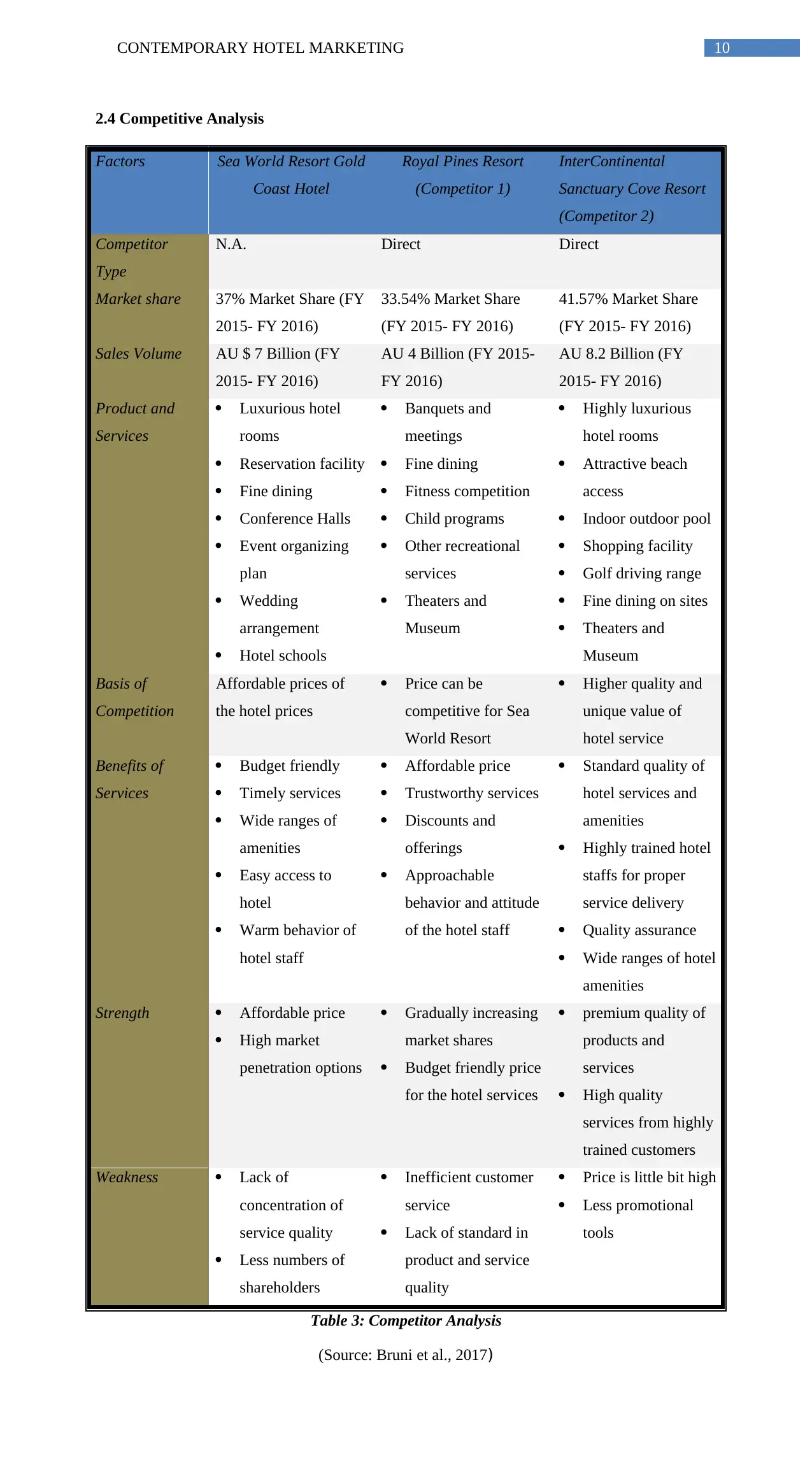
10CONTEMPORARY HOTEL MARKETING
2.4 Competitive Analysis
Factors Sea World Resort Gold
Coast Hotel
Royal Pines Resort
(Competitor 1)
InterContinental
Sanctuary Cove Resort
(Competitor 2)
Competitor
Type
N.A. Direct Direct
Market share 37% Market Share (FY
2015- FY 2016)
33.54% Market Share
(FY 2015- FY 2016)
41.57% Market Share
(FY 2015- FY 2016)
Sales Volume AU $ 7 Billion (FY
2015- FY 2016)
AU 4 Billion (FY 2015-
FY 2016)
AU 8.2 Billion (FY
2015- FY 2016)
Product and
Services
Luxurious hotel
rooms
Reservation facility
Fine dining
Conference Halls
Event organizing
plan
Wedding
arrangement
Hotel schools
Banquets and
meetings
Fine dining
Fitness competition
Child programs
Other recreational
services
Theaters and
Museum
Highly luxurious
hotel rooms
Attractive beach
access
Indoor outdoor pool
Shopping facility
Golf driving range
Fine dining on sites
Theaters and
Museum
Basis of
Competition
Affordable prices of
the hotel prices
Price can be
competitive for Sea
World Resort
Higher quality and
unique value of
hotel service
Benefits of
Services
Budget friendly
Timely services
Wide ranges of
amenities
Easy access to
hotel
Warm behavior of
hotel staff
Affordable price
Trustworthy services
Discounts and
offerings
Approachable
behavior and attitude
of the hotel staff
Standard quality of
hotel services and
amenities
Highly trained hotel
staffs for proper
service delivery
Quality assurance
Wide ranges of hotel
amenities
Strength Affordable price
High market
penetration options
Gradually increasing
market shares
Budget friendly price
for the hotel services
premium quality of
products and
services
High quality
services from highly
trained customers
Weakness Lack of
concentration of
service quality
Less numbers of
shareholders
Inefficient customer
service
Lack of standard in
product and service
quality
Price is little bit high
Less promotional
tools
Table 3: Competitor Analysis
(Source: Bruni et al., 2017)
2.4 Competitive Analysis
Factors Sea World Resort Gold
Coast Hotel
Royal Pines Resort
(Competitor 1)
InterContinental
Sanctuary Cove Resort
(Competitor 2)
Competitor
Type
N.A. Direct Direct
Market share 37% Market Share (FY
2015- FY 2016)
33.54% Market Share
(FY 2015- FY 2016)
41.57% Market Share
(FY 2015- FY 2016)
Sales Volume AU $ 7 Billion (FY
2015- FY 2016)
AU 4 Billion (FY 2015-
FY 2016)
AU 8.2 Billion (FY
2015- FY 2016)
Product and
Services
Luxurious hotel
rooms
Reservation facility
Fine dining
Conference Halls
Event organizing
plan
Wedding
arrangement
Hotel schools
Banquets and
meetings
Fine dining
Fitness competition
Child programs
Other recreational
services
Theaters and
Museum
Highly luxurious
hotel rooms
Attractive beach
access
Indoor outdoor pool
Shopping facility
Golf driving range
Fine dining on sites
Theaters and
Museum
Basis of
Competition
Affordable prices of
the hotel prices
Price can be
competitive for Sea
World Resort
Higher quality and
unique value of
hotel service
Benefits of
Services
Budget friendly
Timely services
Wide ranges of
amenities
Easy access to
hotel
Warm behavior of
hotel staff
Affordable price
Trustworthy services
Discounts and
offerings
Approachable
behavior and attitude
of the hotel staff
Standard quality of
hotel services and
amenities
Highly trained hotel
staffs for proper
service delivery
Quality assurance
Wide ranges of hotel
amenities
Strength Affordable price
High market
penetration options
Gradually increasing
market shares
Budget friendly price
for the hotel services
premium quality of
products and
services
High quality
services from highly
trained customers
Weakness Lack of
concentration of
service quality
Less numbers of
shareholders
Inefficient customer
service
Lack of standard in
product and service
quality
Price is little bit high
Less promotional
tools
Table 3: Competitor Analysis
(Source: Bruni et al., 2017)
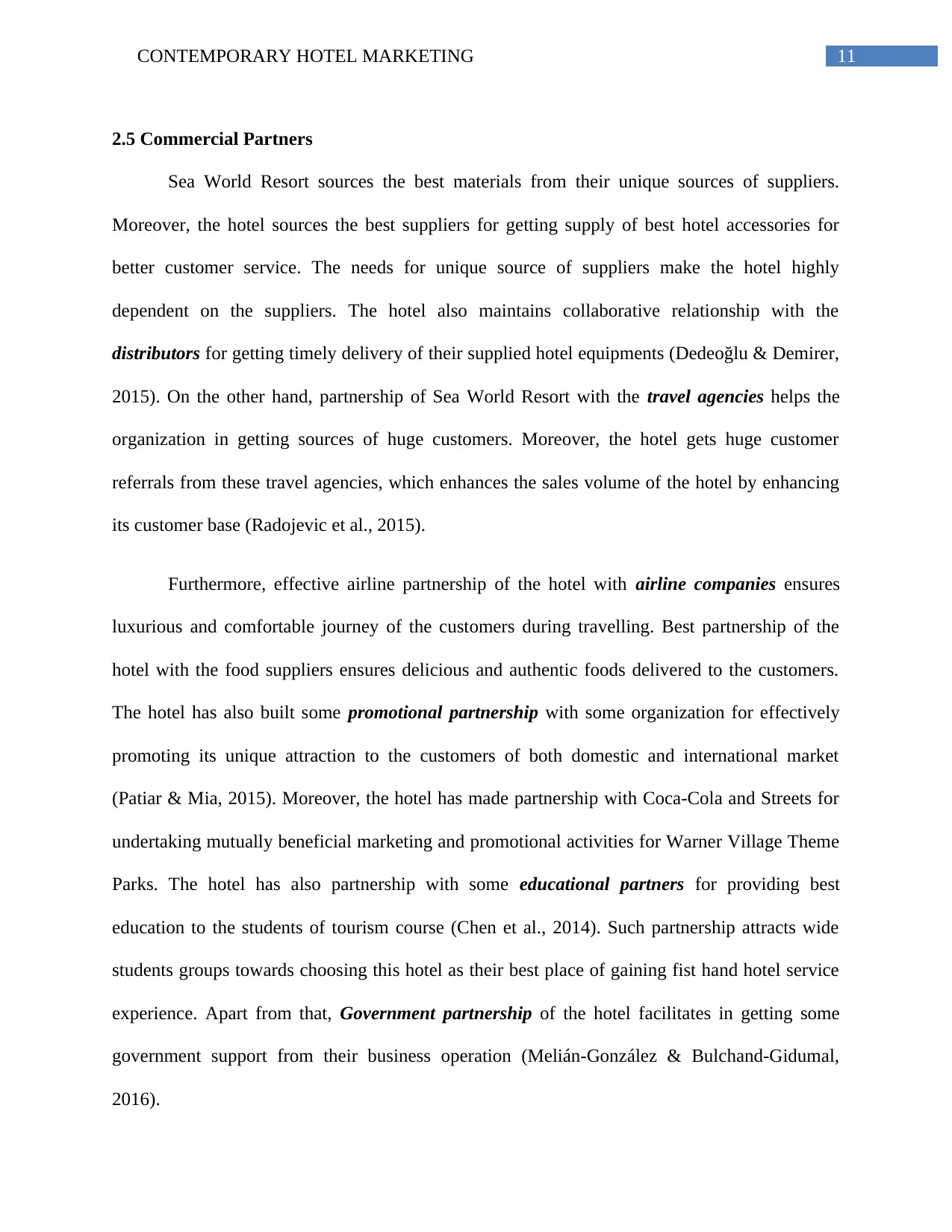
11CONTEMPORARY HOTEL MARKETING
2.5 Commercial Partners
Sea World Resort sources the best materials from their unique sources of suppliers.
Moreover, the hotel sources the best suppliers for getting supply of best hotel accessories for
better customer service. The needs for unique source of suppliers make the hotel highly
dependent on the suppliers. The hotel also maintains collaborative relationship with the
distributors for getting timely delivery of their supplied hotel equipments (Dedeoğlu & Demirer,
2015). On the other hand, partnership of Sea World Resort with the travel agencies helps the
organization in getting sources of huge customers. Moreover, the hotel gets huge customer
referrals from these travel agencies, which enhances the sales volume of the hotel by enhancing
its customer base (Radojevic et al., 2015).
Furthermore, effective airline partnership of the hotel with airline companies ensures
luxurious and comfortable journey of the customers during travelling. Best partnership of the
hotel with the food suppliers ensures delicious and authentic foods delivered to the customers.
The hotel has also built some promotional partnership with some organization for effectively
promoting its unique attraction to the customers of both domestic and international market
(Patiar & Mia, 2015). Moreover, the hotel has made partnership with Coca-Cola and Streets for
undertaking mutually beneficial marketing and promotional activities for Warner Village Theme
Parks. The hotel has also partnership with some educational partners for providing best
education to the students of tourism course (Chen et al., 2014). Such partnership attracts wide
students groups towards choosing this hotel as their best place of gaining fist hand hotel service
experience. Apart from that, Government partnership of the hotel facilitates in getting some
government support from their business operation (Melián-González & Bulchand-Gidumal,
2016).
2.5 Commercial Partners
Sea World Resort sources the best materials from their unique sources of suppliers.
Moreover, the hotel sources the best suppliers for getting supply of best hotel accessories for
better customer service. The needs for unique source of suppliers make the hotel highly
dependent on the suppliers. The hotel also maintains collaborative relationship with the
distributors for getting timely delivery of their supplied hotel equipments (Dedeoğlu & Demirer,
2015). On the other hand, partnership of Sea World Resort with the travel agencies helps the
organization in getting sources of huge customers. Moreover, the hotel gets huge customer
referrals from these travel agencies, which enhances the sales volume of the hotel by enhancing
its customer base (Radojevic et al., 2015).
Furthermore, effective airline partnership of the hotel with airline companies ensures
luxurious and comfortable journey of the customers during travelling. Best partnership of the
hotel with the food suppliers ensures delicious and authentic foods delivered to the customers.
The hotel has also built some promotional partnership with some organization for effectively
promoting its unique attraction to the customers of both domestic and international market
(Patiar & Mia, 2015). Moreover, the hotel has made partnership with Coca-Cola and Streets for
undertaking mutually beneficial marketing and promotional activities for Warner Village Theme
Parks. The hotel has also partnership with some educational partners for providing best
education to the students of tourism course (Chen et al., 2014). Such partnership attracts wide
students groups towards choosing this hotel as their best place of gaining fist hand hotel service
experience. Apart from that, Government partnership of the hotel facilitates in getting some
government support from their business operation (Melián-González & Bulchand-Gidumal,
2016).
⊘ This is a preview!⊘
Do you want full access?
Subscribe today to unlock all pages.

Trusted by 1+ million students worldwide
1 out of 28
Related Documents
Your All-in-One AI-Powered Toolkit for Academic Success.
+13062052269
info@desklib.com
Available 24*7 on WhatsApp / Email
![[object Object]](/_next/static/media/star-bottom.7253800d.svg)
Unlock your academic potential
Copyright © 2020–2025 A2Z Services. All Rights Reserved. Developed and managed by ZUCOL.





